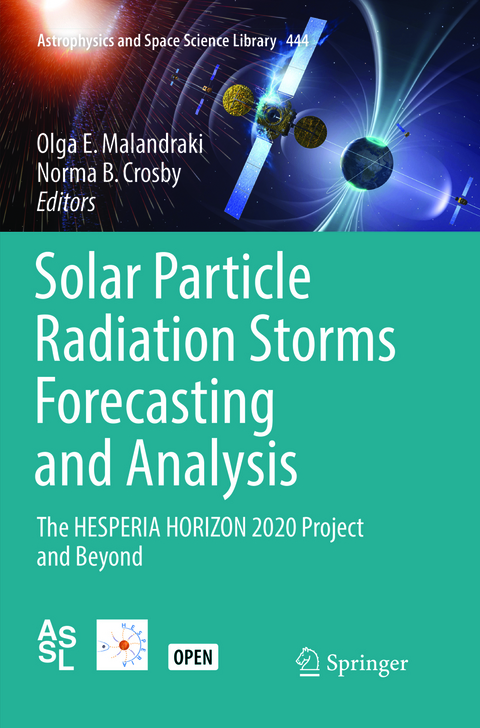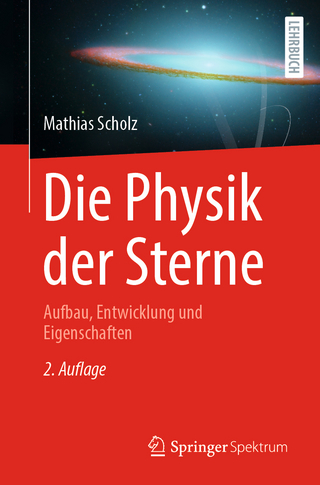
Solar Particle Radiation Storms Forecasting and Analysis
Springer International Publishing (Verlag)
978-3-319-86766-3 (ISBN)
This book is published with open access under a CC BY license.
Dr. Olga E. Malandraki, Ph.D. is a Senior Researcher at the National Observatory of Athens, IAASARS. She has wide expertise in the analysis and interpretation of SEP data from the Ulysses, ACE, Wind and STEREO missions. She has investigated the magnetic topology of ICMEs using SEPs as tracers, the effect of the large-scale structure of the IMF on the propagation of energetic particles, the propagation of energetic particles inside Corotating Interactions Regions (CIRs), the solar origin of SEP events, the physical mechanisms leading to the establishment and maintenance of the so-called 'particle reservoirs' in the heliosphere, the propagation of energetic particles over the poles of the Sun, multi-spacecraft compositional SEP studies in the 3-D heliosphere as well as SEP forecasting and space weather impacts. The results of her studies have been published in more than 55 papers in refereed journals which have attracted a large number of citations. She serves as an Associate Editor and Editorial Board Member of two international peer-review journals as well as Co-editor for conference proceedings (e.g. Proceedings of the International Astronomical Union (IAU) Symposium Nr. 335 on "Space Weather of the Heliosphere: Processes and Forecasts"). She frequently contributes as referee in journals such as Solar Physics, Astrophysical Journal, Journal of Geophysical Research - Space Physics, Planetary and Space Science, Space Weather: The International Journal of Research and Applications. She acts as 'Deputy President' and 'Heliosphere Science Officer' of the Solar-Terrestrial Sciences Division of the European Geosciences Union (EGU), as Spokesperson of the Space Weather Working Team (SWWT) Topical Working sub-group on 'Solar Energetic Particles' of the European Space Agency (ESA), Chair of the Steering Committee of the 'Balkan, Black Sea and Caspian Sea Regional Network for Space Weather Studies' comprising 13 countries, as well as Organizing Committee Member of the IAU Commission E3 on 'Solar Impact throughout the Heliosphere'. She has successfully coordinated the activities as Scientific Responsible, team leader for NOA in the FP7/COMESEP and SEPServer projects. She is the Coordinator of the very successful 'HESPERIA' HORIZON 2020 project of the European Union on 'Space Weather' as well as Scientific Responsible and team leader for NOA. Dr. Eng. Norma B. Crosby has an interdisciplinary background in space physics, engineering, and administration. She has a PhD in Astrophysics and Space Technology (University of Paris 7, France), a Master of Science in Chemical Engineering (Technical University of Denmark, Denmark), and has participated in the International Space University (ISU) Summer Session Programme. For more than 20 years her main research interests have covered the analysis and interpretation of solar flares, solar energetic particle events, statistical analyses of space plasma data, extr eme space phenomena events, effects of space weather phenomena on technology and human health, and self-organized criticality while working at various Institutes in Europe as well as both ESA/ESTEC and NASA/GSFC. Since 2002 she has worked as a scientist at the Royal Belgian Institute for Space Aeronomy (BIRA-IASB), Belgium, where her function as co-leader of the Space Weather Group concerns linking basic science with applied science. She has been responsible for several EU and ESA space weather related projects, including the EU FP7 COMESEP Project of which she was Project Coordinator and the ESA SEPEM Project of which she was Project Manager. Additionally, she served as Project Coordinator of the two-year INTAS Network Project, "Key Parameters for Space Weather" (2000-0752), comprised of 18 teams from INTAS and NIS countries. She is Team Leader for BIRA-IASB in the EU H2020 HESPERIA Project and is Coordinator of the ESA Space Situational Awareness Space Radiation Expert Service Centr
Preface.- Solar Energetic Particles and Space Weather: Science and Applications.- Eruptive Solar Activity related to SEP Events.- Charged Particle Transport in the Interplanetary Medium.- Particle Transport in the Earth's Magnetosphere.- Ground-Based Measurements of High-Energy Particles by Neutron Monitors.- HESPERIA Forecasting Tools: Real-Time and Post-Event.- Gamma-Ray, Radio and SEP Observations of Relativistic Events.- Modelling of Shock-Accelerated Gamma-Ray Events.- Inversion Methodology of Ground Level Enhancements.
| Erscheinungsdatum | 26.02.2019 |
|---|---|
| Reihe/Serie | Astrophysics and Space Science Library |
| Zusatzinfo | XIII, 203 p. 73 illus., 54 illus. in color. |
| Verlagsort | Cham |
| Sprache | englisch |
| Maße | 155 x 235 mm |
| Gewicht | 340 g |
| Themenwelt | Naturwissenschaften ► Physik / Astronomie ► Astronomie / Astrophysik |
| Schlagworte | Coronal mass ejections • Gamma-ray flares • open access • Particle acceleration in the solar corona • solar energetic particles • solar flares • Solar Wind Shock Waves • Space Weather forecasting |
| ISBN-10 | 3-319-86766-0 / 3319867660 |
| ISBN-13 | 978-3-319-86766-3 / 9783319867663 |
| Zustand | Neuware |
| Informationen gemäß Produktsicherheitsverordnung (GPSR) | |
| Haben Sie eine Frage zum Produkt? |
aus dem Bereich


